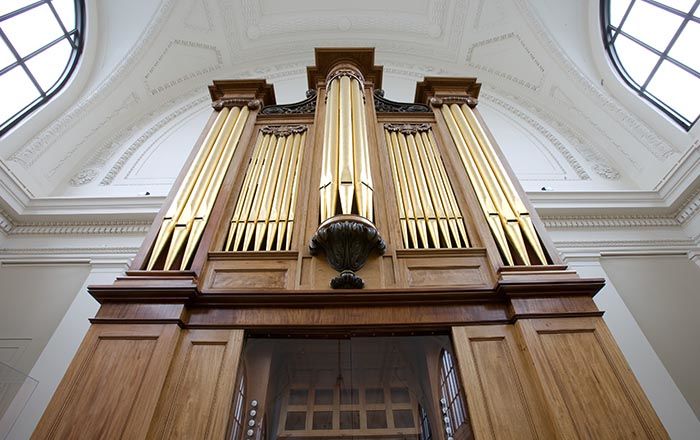Upright Piano
Friedrich Bernhard Voigt German
Not on view
Friedrich Bernhard Voigt established his piano making workshop in 1813 in Berlin and became designated as a court instrument maker in 1825. His son Carl Ludwig Friedrich later joined the workshop. It ceased to exist with the death of the younger Voigt in 1874.
Technical description: Vertical mahogany veneer case curving upward toward left side, terminating in a square pediment surrounded with carved gilt molding, a smaller similar pediment at lower right side of curve, the ornaments formerly surmounting the pediments now absent; front vertical panels and 2 doors below keyboard backed with green cloth, with brass bead edging and cast brass ornaments; 3-piece hinged keyboard cover (holding music rack) decorated with brass mermaids, fleur-de-lis and other floral designs (central ornament broken); 2 fluted column legs at front, with vertical brass beading and brass collars at both ends; nameboard edged at top with ebony-ivory inlay and holding oval white glass nameplate framed in brass; compass EE-f4 (74 keys), ivory naturals (fronts missing), ebony slips over stained accidental blocks; 4 brass covered pedals; center pair coupled and operating mute stop, left shifting action for una corda, right raising dampers; German "hanging" action with escapement, hammers mounted in brass kapsels with spring return; stained soundboard; bridge entirely backpinned; square tuning pins (possibly replacements), note names stamped on pinblock, string gauges inked on bridge; strings up to d2 damped by felt and leather-padded L-arms mounted with screws to batten and returned by wire springs; probably 16 more dampers originally; top 45 notes triple-strung, remainder double-strung, lowest 6 notes wound; damper rail and pads possibly replacements.
This image cannot be enlarged, viewed at full screen, or downloaded.

